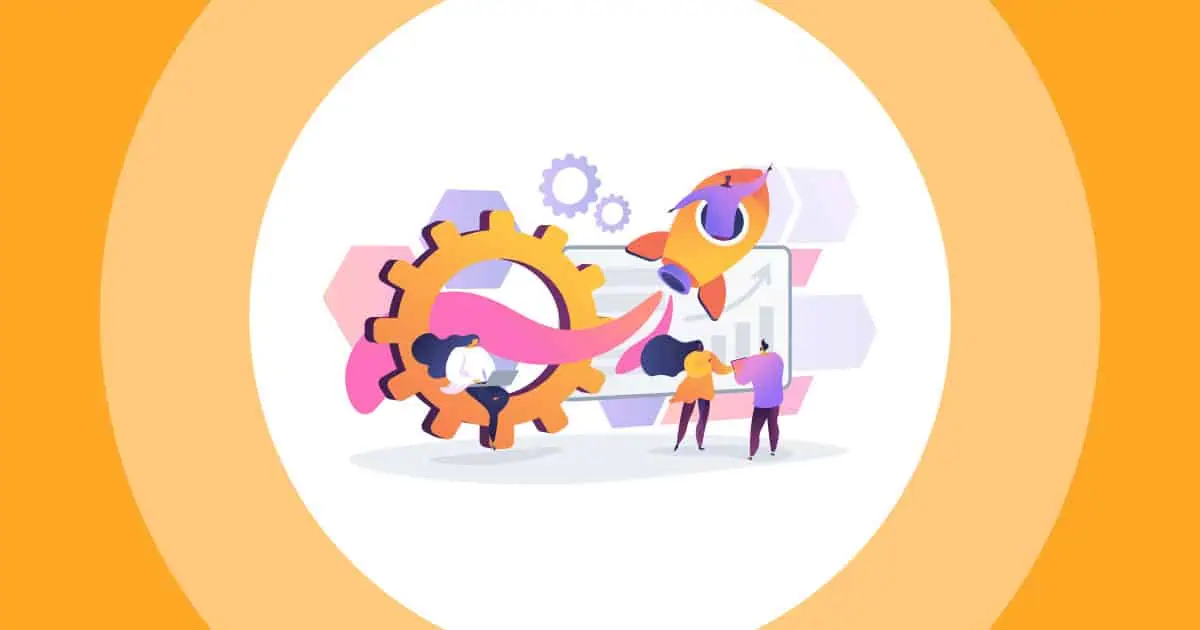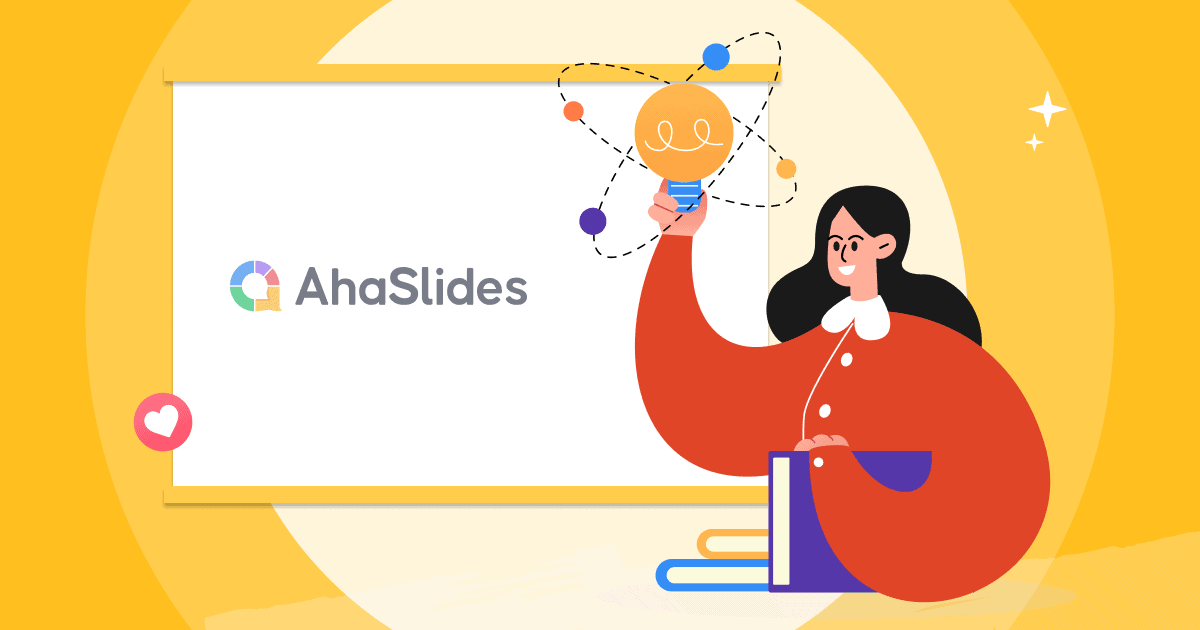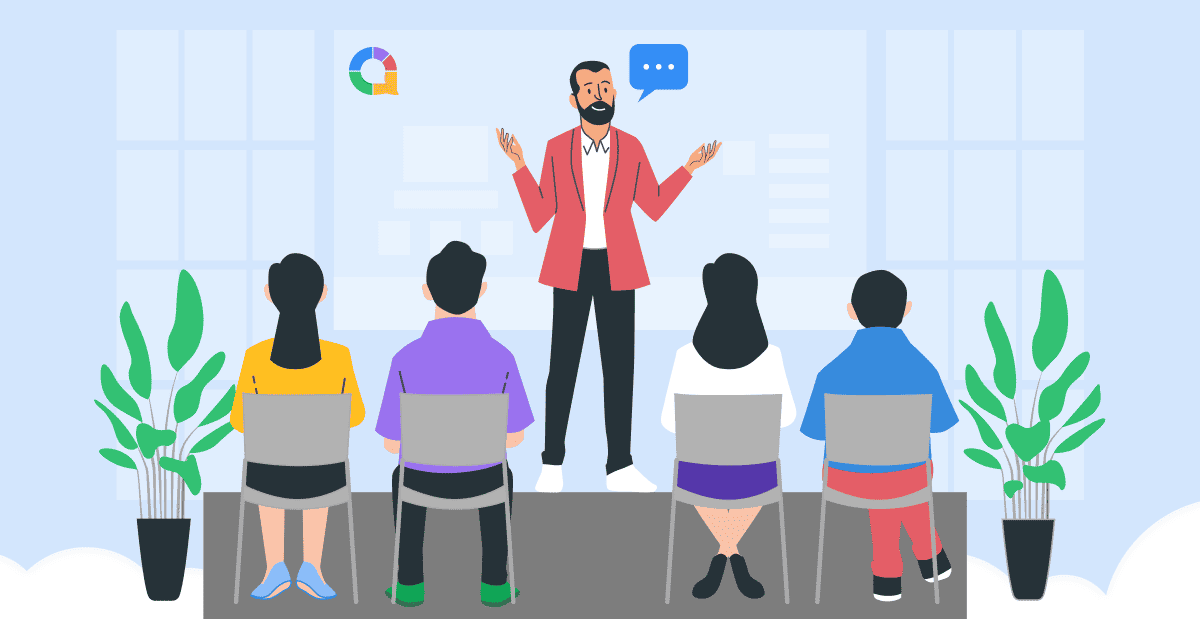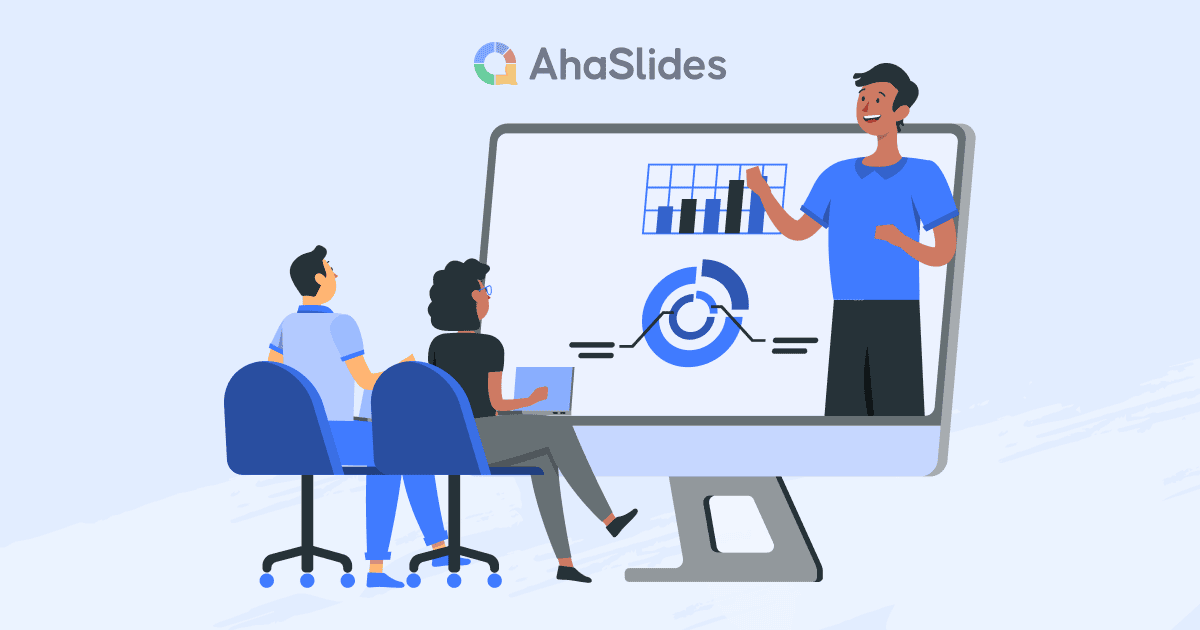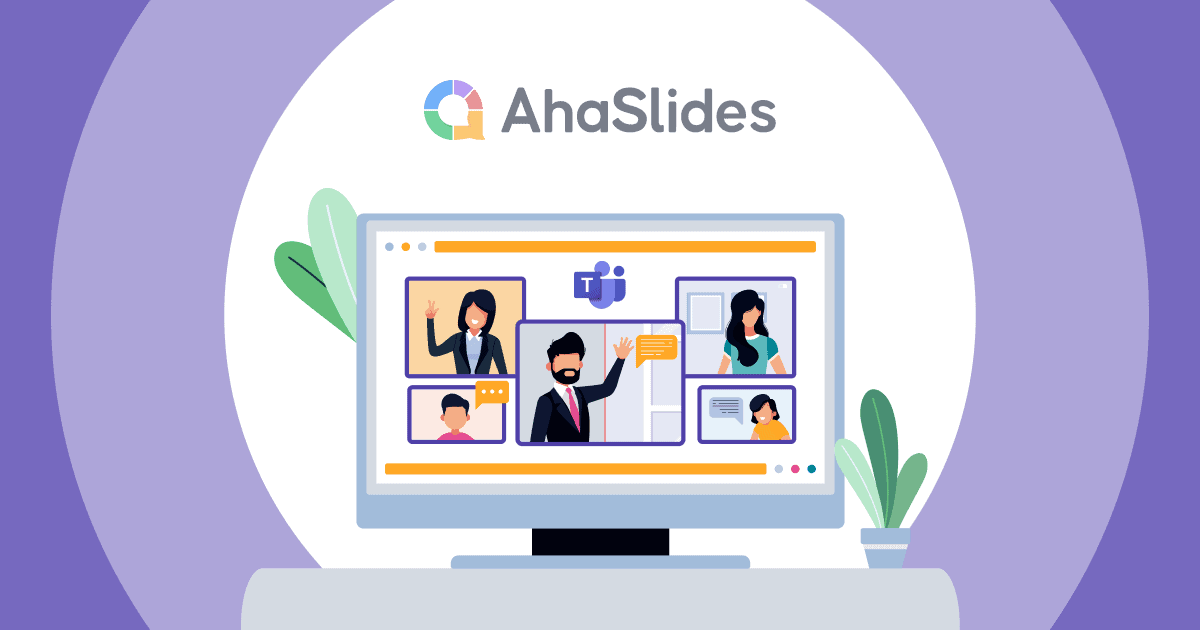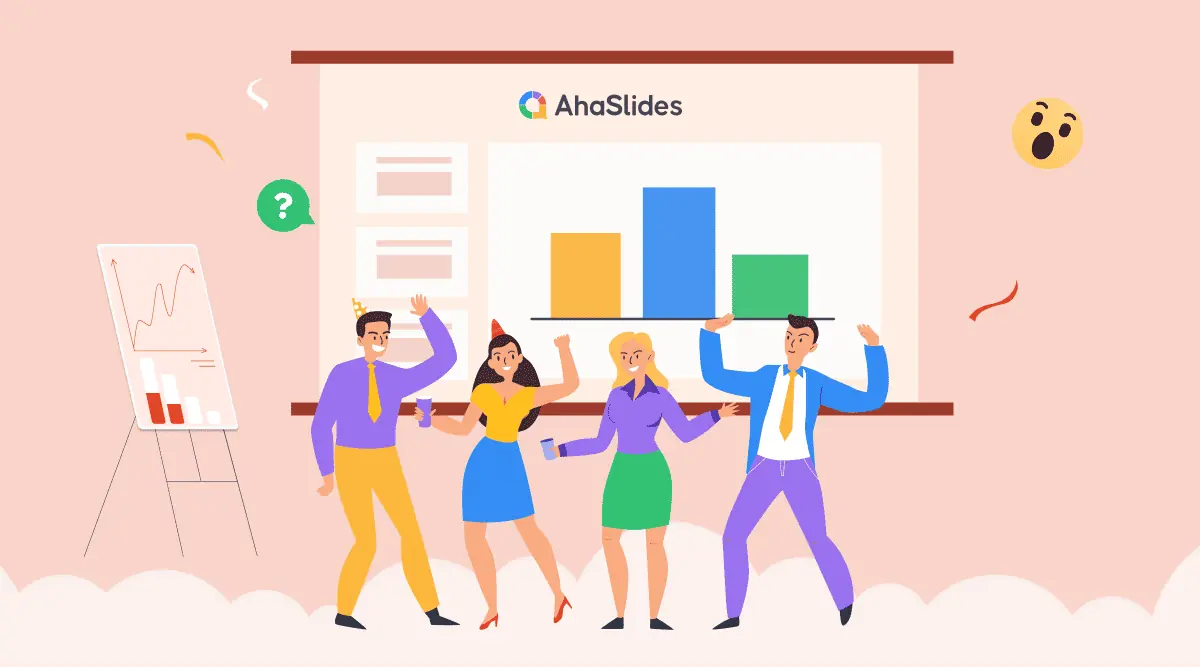Ke ola nei mākou i kahi au e like me ka lepo gula. Maikaʻi a paʻakikī ke hele mai.
Hoʻohana ʻo TikTokers i nā hola e hoʻoponopono ana i nā wikiō, i ka hoʻāʻo ʻana e hoʻopaʻa i nā mea nānā i nā kekona mua ʻekolu.
Ua kaumaha nā YouTubers ma luna o nā kiʻi liʻiliʻi a me nā poʻo inoa, pono kēlā me kēia mea e kū i waho i ke kai o ka ʻike pau ʻole.
A me nā mea nūpepa? Hākōkō lākou me kā lākou laina wehe. E kiʻi pololei, a pili ka poʻe heluhelu. E kuhi hewa, a poof - ua hala lākou.
ʻAʻole pili kēia i ka leʻaleʻa. He hōʻike ia o ka hoʻololi hohonu ʻana i ke ʻano o kā mākou ʻai ʻana i ka ʻike a me ka launa pū ʻana me ka honua a puni mākou.
ʻAʻole ma ka pūnaewele wale nō kēia pilikia. Aia ma nā wahi a pau. Ma nā lumi papa, nā lumi papa, ma nā hanana nui. Ua like mau ka nīnau: Pehea mākou e hopu ʻole ai i ka nānā, akā paʻa? Pehea mākou e hoʻohuli ai i ka hoihoi pōkole i pili pono?
ʻAʻole paʻakikī e like me kou manaʻo. Ua loaʻa iā AhaSlides ka pane: hoʻohua ka launa pū ʻana.
Inā ʻoe e aʻo ana ma ka papa, e hoʻokomo i nā mea āpau ma ka ʻaoʻao hoʻokahi ma ka hana, a i ʻole e hui pū ana i kahi kaiāulu, ʻo AhaSlides ka mea maikaʻi loa. hōʻike pāʻani mea hana e pono ai ʻoe e kamaʻilio, hoʻopili, a hoʻoikaika.
No laila, e ʻike kākou pehea e hana ai i kahi hōʻike pāʻani me ka hoʻohana ʻana iā AhaSlides i poina ʻole i kāu poʻe hoʻolohe!
Table of Contents
Table of Contents
- He aha ka hōʻike pāʻani?
- Pehea e hana ai i nā hōʻikeʻike pili me AhaSlides
- No ke aha e koho ai i ka AhaSlides no nā hōʻike hoʻohālikelike?
- 5 mau ala maikaʻi e hana ai i nā hōʻike pāʻani
- 9 mau ʻanuʻu no nā mea hōʻike pāʻani e hoʻohiwahiwa i nā mea hoʻolohe
- ʻO nā kaukani o nā hōʻikeʻike kūleʻa kūleʻa e hoʻohana ana i ka AhaSlides…
- Pinepine ninau ninaninau 'ana i
He aha ka hōʻike pāʻani?
ʻO ka hōʻike pānaʻi he ʻano hana hoʻohiwahiwa o ka hāʻawi ʻana i ka ʻike kahi e komo ikaika ai ka poʻe ma mua o ka hoʻolohe wale ʻana. Ke hoʻohana nei kēia ʻano i nā koho balota ola, nā nīnau nīnau, Q&As, a me nā pāʻani e hoʻokomo pono i ka poʻe nānā me ka ʻike. Ma kahi o ke kamaʻilio ʻaoʻao hoʻokahi, kākoʻo ia i ke kamaʻilio ʻelua ʻaoʻao, e ʻae ana i ka poʻe e hoʻohālike i ke kahe a me ka hopena o ka hōʻike. Hoʻolālā ʻia ka hōʻike pāʻani no ka hoʻoikaika ʻana i ka poʻe, kōkua iā lākou e hoʻomanaʻo i nā mea, a hana i kahi hoʻonaʻauao hui pū ʻana [1] a i ʻole kaiapuni kūkākūkā.
Nā pōmaikaʻi nui o nā hōʻike pāʻani:
Hoʻonui ʻia ka hui ʻana o ka poʻe: Noho ka poʻe hoʻolohe i ka hoihoi a me ka noʻonoʻo i ka wā e komo ikaika ai lākou.
ʻoi aku ka maikaʻi o ka hoʻomanaʻo: Kōkua nā hana pāʻani iā ʻoe e hoʻomanaʻo i nā mea koʻikoʻi a hoʻoikaika i nā mea āu i loaʻa ai.
Nā hopena aʻo i hoʻonui ʻia: Ma nā hoʻonohonoho hoʻonaʻauao, alakaʻi ka pilina i kahi ʻike maikaʻi.
ʻOi aku ka maikaʻi o ka hui pū ʻana: ʻO nā hōʻike pāʻani e maʻalahi i nā poʻe ke kamaʻilio pū kekahi i kekahi a kaʻana like i nā manaʻo.
Manaʻo manawa maoli: Hāʻawi nā koho balota a me nā noiʻi i nā manaʻo kūpono i ka manawa maoli.
Pehea e hana ai i nā hōʻikeʻike pili me AhaSlides
ʻO ke alakaʻi i kēlā me kēia ʻanuʻu no ʻoe e hana i kahi hōʻike kūkākūkā me ka hoʻohana ʻana iā AhaSlides i kekahi mau minuke:
1. Ana
E hana i kahi moʻokāki AhaSlides manuahi a koho i kahi hoʻolālā kūpono e pili ana i kāu pono.
2. Hana i kahi hōʻikeʻike houn
No ka hana ʻana i kāu hōʻike mua, kaomi i ke pihi i kapa ʻia 'Hōʻike hou ' a i ʻole e hoʻohana i hoʻokahi o nā mamana i hoʻolālā mua ʻia.
A laila, hāʻawi i kāu hōʻike i kahi inoa, a inā makemake ʻoe, kahi code komo maʻamau.
E lawe pololei ʻia ʻoe i ka mea hoʻoponopono, kahi e hoʻomaka ai e hoʻoponopono i kāu hōʻike.
3. Hoʻohui i nā paheʻe
E koho mai nā ʻano slide like ʻole.
4. Hoʻopilikino i kāu mau paheʻe
Hoʻohui i nā ʻike, hoʻoponopono i nā font a me nā kala, a hoʻokomo i nā mea multimedia.
5. Hoʻohui i nā hana pili
E hoʻonohonoho i nā koho balota, nā nīnau nīnau, nā hālāwai Q&A, a me nā hiʻohiʻona ʻē aʻe.
6. Hōʻike i kāu hōʻikeʻike
Kaʻana like i kāu hōʻikeʻike me kāu poʻe hālāwai ma o kahi loulou kūʻokoʻa a i ʻole QR code, a hauʻoli i ka ʻono o ka pilina!
koaNā Hōʻike Kūkākūkā no ka manuahi!
E hoʻohui i nā mea pāʻani e hoʻoulu ai i ka lehulehu.
E hoʻomanaʻo i kāu hanana holoʻokoʻa no ka lehulehu, ma nā wahi āpau, me AhaSlides.
No ke aha e koho ai i ka AhaSlides no nā hōʻike hoʻohālikelike?
Nui nā polokalamu hōʻike hōʻikeʻike ma waho, akā kū ʻo AhaSlides i ka maikaʻi loa. E nānā kākou i ke kumu e ʻā maoli ai ʻo AhaSlides:
Nā hiʻohiʻona like ʻole
ʻOiai e hāʻawi ana nā mea hana ʻē aʻe i kekahi mau mea pili, ua hoʻokiʻekiʻe ʻo AhaSlides i kahi hui piha o nā hiʻohiʻona. Hāʻawi kēia kahua hōʻike pāʻani iā ʻoe e hoʻokō pono i kāu mau paheʻe i kāu mau pono, me nā hiʻohiʻona e like me ke koho balota ola, nā nīnau nīnau, nā hālāwai Q&A, a me nā ao huaʻōlelo e hoʻomau i ka makemake o kāu poʻe i ka manawa holoʻokoʻa.
Kūpono
ʻAʻole pono nā mea hana maikaʻi e uku i ka honua. Hoʻopili ʻo AhaSlides i kahi punch me ka ʻole o ke kumu kūʻai nui. ʻAʻole pono ʻoe e uhaʻi i ka panakō no ka hana ʻana i nā hōʻikeʻike hoʻohiwahiwa.
Puu o uaaiieiu
Inā ʻoe he mea hōʻike ʻike a i ʻole e hoʻomaka wale ana, ʻo ka waihona nui o AhaSlides o nā hoʻohālike i hoʻolālā mua ʻia e maʻalahi ke hoʻomaka. Hoʻopilikino iā lākou e hoʻohālikelike i kāu hōʻailona a i ʻole hana i kahi mea kūʻokoʻa loa - iā ʻoe ke koho.
Hoʻohui maikaʻi ʻole
Aia nā manawa pau ʻole me AhaSlides no ka mea hana maikaʻi me nā mea hana āu i ʻike ai a aloha ai. Loaʻa ʻia ʻo AhaSlides ma ke ʻano he hoʻonui no PowerPoint, Google Slides a me Microsoft Teams. Hiki iā ʻoe ke hoʻohui i nā wikiō YouTube, Google Slides/PowerPoint maʻiʻo, a i ʻole nā mea mai nā kahua ʻē aʻe me ka hoʻōki ʻole i ke kahe o kāu hōʻike.
ʻIke manawa maoli
ʻAʻole hana wale ʻo AhaSlides i kāu mau hōʻikeʻike, hāʻawi ia iā ʻoe i ka ʻikepili waiwai. E hoʻopaʻa i ka mea e komo nei, pehea ka pane ʻana o ka poʻe i kekahi mau paheʻe, a aʻo hou e pili ana i ka mea āu e makemake ai. Hoʻohana ʻia kēia loop loop i ka manawa maoli, no laila hiki iā ʻoe ke hoʻololi i kāu mau kamaʻilio i ka minuke hope a hoʻomau i ka maikaʻi.
ʻO nā hiʻohiʻona nui o AhaSlides:
- Nā koho balota ola: E hōʻiliʻili i nā manaʻo manaʻo koke mai kāu poʻe hālāwai ma nā kumuhana like ʻole.
- Nā nīnau nīnau a me nā pāʻani: Hoʻohui i kahi mea leʻaleʻa a me ka hoʻokūkū i kāu hōʻike.
- Nā nīnau nīnau: E paipai i ke kamaʻilio wehe ʻana a me ka hoʻopuka ʻana i nā nīnau o ka lehulehu i ka manawa maoli.
- Nā ao huaʻōlelo: E nānā i nā manaʻo a me nā manaʻo hui.
- huila milo: Hoʻokomo i ka hauʻoli a me ka randomness i kāu hōʻike.
- Hoʻohui me nā mea hana kaulana: Hana maikaʻi ʻo AhaSlides me nā mea hana āu i ʻike ai a aloha ai, e like me PowerPoint, Google Slides, a me MS Teams.
- Kaʻikepili ʻikepili: E hahai i ke komo ʻana o ka lehulehu a loaʻa nā ʻike waiwai.
- Nā koho hoʻopilikino: E hoʻohālikelike i kāu hōʻikeʻike i kāu hōʻailona a i ʻole kou ʻano ponoʻī.
ʻOi aku ka AhaSlides ma mua o kahi hāmeʻa hōʻikeʻike manuahi manuahi. ʻOiaʻiʻo, he ala e hoʻopili ai, hoʻopili, a kamaʻilio maikaʻi. ʻO kēia ke koho maikaʻi loa inā makemake ʻoe e hoʻomaikaʻi i kāu mau kamaʻilio a hana i ka hopena i kāu poʻe e hoʻolohe mau nei.
Hoʻohālikelike me nā mea hana hōʻike pāʻani ʻē aʻe:
ʻO nā mea hana hōʻike pāʻani ʻē aʻe, e like me Slido, Kahoot, a me Mentimeter, he mau hiʻohiʻona ikaika, akā ʻo AhaSlides ka mea maikaʻi loa no ka mea maʻalahi, maʻalahi e hoʻohana, a maʻalahi. ʻO ka loaʻa ʻana o ka nui o nā hiʻohiʻona a me ka hoʻohui ʻana e hana ʻo AhaSlides i kahi koho kūpono no kāu pono hōʻike pāʻani āpau. E ʻike kākou no ke aha ʻo AhaSlides kekahi o nā koho Kahoot maikaʻi loa:
| AlaAlides | kahoot | |
|---|---|---|
| kumu kūʻai | ||
| ʻO ka papahana kaʻawale | - Kākoʻo kamaʻilio ola - A hiki i 50 mau mea komo i kēlā me kēia kau | - ʻAʻohe kākoʻo i hana mua ʻia - Ma kahi o 20 mau mea komo i kēlā me kēia kau |
| Nā hoʻolālā mahina mai | $23.95 | ✕ |
| Nā papahana makahiki mai | $95.40 | $204 |
| Kākoʻo kākoʻo | Hoʻolālā a pau | ʻO ke kumumanaʻo |
| ʻano | ||
| huila milo | ✅ | ✕ |
| Nā pane o ka poʻe hoʻolohe | ✅ | ✅ |
| Nīnau nīnau pāʻani (koho he nui, ʻelua pāʻani, kūlana, ʻano pane) | ✅ | ✕ |
| ʻano pāʻani hui | ✅ | ✅ |
| Mea hoʻoheheʻe AI | ✅ | ✅ (nā papahana uku kiʻekiʻe wale nō) |
| Ka hopena kani kuʻikahi | ✅ | ✅ |
| Heluhelu & Manaʻo | ||
| Nūnūnū (nā koho koho lehulehu, huaʻōlelo cloud & open-ended, brainstorming, scale rating, Q&A) | ✅ | ✕ |
| ʻO ka nīnau pāʻani ponoʻī | ✅ | ✅ |
| ʻIkepili hopena o nā mea komo | ✅ | ✅ |
| Hōʻike ma hope o ka hanana | ✅ | ✅ |
| Nā Kūlelehana | ||
| ʻO ka hōʻoia o nā mea komo | ✅ | ✕ |
| Nā Pāʻoihana | - Nā kiʻi Google –PowerPoint - Nā hui MS – Hopin | –PowerPoint |
| Hiki ke hoʻopilikino ʻia | ✅ | ✕ |
| Nā leo hiki ke hana | ✅ | ✅ |
| Pākuʻi hoʻohālike | ✅ | ✕ |
5 mau ala maikaʻi e hana ai i nā hōʻike pāʻani
Ke noʻonoʻo nei ʻoe pehea e hana ai i kahi hōʻikeʻike kūkākūkā a me ke ʻano hoihoi? Eia nā kī:
Nā hana hoʻoheheʻe hau
ʻO nā hana Icebreaker kahi ala maikaʻi loa e hoʻomaka ai i kāu hōʻike a hana i kahi lewa hoʻokipa. Kōkua lākou i ka uhaki ʻana i ka hau ma waena o ʻoe a me kāu poʻe hoʻolohe, a hiki iā lākou ke kōkua pū i ka hoʻokomo ʻana i kāu poʻe i ka mea. Eia kekahi mau manaʻo no nā hana hoʻoheheʻe hau.
- Nā inoa pāʻani: E noi i nā haumāna e haʻi i ko lākou inoa a me kahi mea hoihoi e pili ana iā lākou iho.
- ʻElua mau ʻoiaʻiʻo a me ka wahaheʻe: E hōʻike i kēlā me kēia kanaka i ʻekolu mau ʻōlelo e pili ana iā lākou iho, ʻelua he ʻoiaʻiʻo a he wahaheʻe kekahi. Manaʻo nā lālā ʻē aʻe o ke anaina i ka ʻōlelo o ka wahaheʻe.
- Makemake ʻoe?: E nīnau i kāu poʻe hālāwai i kahi pūʻulu o "Makemake ʻoe?" ninau. He ala maikaʻi kēia e noʻonoʻo a kamaʻilio ai kāu poʻe hālāwai.
- Nā koho: E hoʻohana i kahi mea hana koho balota e nīnau i kāu poʻe hālāwai i kahi nīnau leʻaleʻa. He ala maikaʻi kēia e komo ai nā mea a pau a e uhaʻi i ka hau.
Kākalakala
ʻO ka haʻi moʻolelo kahi ala ikaika e hoʻohauʻoli ai i kāu poʻe e hoʻolohe ai a hoʻopili i kāu leka. Ke haʻi ʻoe i kahi moʻolelo, ke hoʻopaʻa nei ʻoe i ka manaʻo a me ka noʻonoʻo o kāu poʻe hoʻolohe. Hiki i kēia ke hoʻomanaʻo i kāu hōʻikeʻike.
No ka hana ʻana i nā moʻolelo koʻikoʻi:
- E hoʻomaka me kahi makau ikaika: E hopu i ka noonoo o kou anaina mai kinohi mai me ka makau ikaika. He nīnau paha kēia, he ʻoiaʻiʻo kamahaʻo, a he moʻolelo pilikino paha.
- E mālama pono i kāu moʻolelo: E hōʻoia e pili ana kāu moʻolelo i kāu kumuhana hōʻike. Pono kāu moʻolelo e hōʻike i kāu mau manaʻo a hoʻomanaʻo i kāu leka.
- E hoʻohana i ka ʻōlelo olaola: E hoʻohana i ka ʻōlelo olaola e pena i ke kiʻi ma ka noʻonoʻo o kāu poʻe anaina. E kōkua kēia iā lākou e hoʻopili me kāu moʻolelo ma kahi pae manaʻo.
- E hoʻololi i kāu wikiwiki: Mai ʻōlelo me ka monotone. E hoʻololi i kāu wikiwiki a me ka leo e hoʻomau i kāu poʻe e hoʻolohe.
- E hoʻohana i nā hiʻohiʻona: E hoʻohana i nā kiʻi e hoʻokō i kāu moʻolelo. Hiki paha kēia i nā kiʻi, nā wikiō, a i ʻole nā mea pono.
Nā mea hana manaʻo ola
Hiki i nā mea hana manaʻo ola ke paipai i ke komo ʻana a hōʻiliʻili i nā ʻike koʻikoʻi mai kāu poʻe hālāwai. Ma ka hoʻohana ʻana i kēia mau mea hana, hiki iā ʻoe ke ana i ka hoʻomaopopo ʻana o kāu poʻe ʻike i ka mea, e ʻike i nā wahi e pono ai lākou e hoʻomaʻamaʻa hou aʻe, a loaʻa i nā manaʻo no kāu hōʻike holoʻokoʻa.
E noʻonoʻo e hoʻohana:
- Nā koho: E hoʻohana i nā koho balota e nīnau i kāu poʻe hālāwai i kāu hōʻike. He ala maikaʻi kēia e loaʻa ai kā lākou manaʻo i kāu ʻike a hoʻomau iā lākou.
- Nā nīnau nīnau: E hoʻohana i kahi mea hana Q&A e ʻae i kāu poʻe e hoʻouna i nā nīnau me ka inoa ʻole i kāu hōʻike. He ala maikaʻi kēia e hoʻoponopono ai i nā pilikia a lākou e loaʻa ai a mālama iā lākou i ka mea.
- Nā ao huaʻōlelo: E hoʻohana i kahi huaʻōlelo cloud mea hana e hōʻiliʻili i nā manaʻo mai kāu poʻe hālāwai ma kahi kumuhana kikoʻī. He ala maikaʻi kēia e ʻike ai i nā huaʻōlelo a me nā ʻōlelo i manaʻo ʻia ke noʻonoʻo lākou i kāu kumuhana hōʻike.
Gamify ka hōʻike
ʻO ka hoʻonani ʻana i kāu hōʻikeʻike he ala maikaʻi loa ia e hoʻomau a hoʻoikaika i kāu poʻe e ʻike ai. Hiki i nā pāʻani hōʻike pāʻani ke hoʻolilo i kāu hōʻikeʻike i ʻoi aku ka leʻaleʻa a me ka launa pū ʻana, a hiki ke kōkua pū i kāu poʻe e aʻo a mālama pono i ka ʻike.
E hoʻāʻo i kēia mau hoʻolālā pāʻani:
- E hoʻohana i nā nīnau a me nā koho balota: E hoʻohana i nā nīnau nīnau a me nā koho balota e hoʻāʻo i ka ʻike o kāu mea e ʻike ai i ka mea. Hiki iā ʻoe ke hoʻohana iā lākou no ka hāʻawi ʻana i nā helu i ka poʻe i pane pololei.
- E hana i nā pilikia: E hana i nā paʻakikī no kāu anaina e hoʻopau i kāu hōʻike. He mea paha kēia mai ka pane pololei ʻana i kahi nīnau a hiki i ka hoʻopau ʻana i kahi hana.
- E hoʻohana i kahi papa kuhikuhi: E hoʻohana i kahi papa alakaʻi no ka nānā ʻana i ka holomua o kāu poʻe hālāwai i ka wā o ka hōʻike. E kōkua kēia iā lākou e hoʻoikaika a hoʻoikaika.
- Hāʻawi i nā makana: Hāʻawi i nā makana i ka poʻe i lanakila i ka pāʻani. Hiki paha kēia i kekahi mea mai kahi makana a i kahi helu bonus ma kā lākou hoʻokolohua aʻe.
Nā noiʻi ma mua a ma hope o ka hanana
Hiki i nā noiʻi ma mua a ma hope o ka hanana ke kōkua iā ʻoe e hōʻiliʻili i nā manaʻo mai kāu poʻe hālāwai a hoʻomaikaʻi i kāu mau hōʻikeʻike i ka manawa. Hāʻawi nā noiʻi ma mua o ka hanana i kahi manawa e ʻike ai i nā manaʻolana o kāu poʻe e hoʻolohe a hoʻoponopono i kāu hōʻike e like me ia. Hiki iā ʻoe ke ʻike i nā mea i makemake ʻia a makemake ʻole ʻia e kāu poʻe e pili ana i kāu hōʻike, a hiki iā lākou ke kōkua iā ʻoe e ʻike i nā wahi e hoʻomaikaʻi ai.
Eia kekahi mau ʻōlelo aʻoaʻo no ka hoʻohana ʻana i nā noiʻi ma mua a ma hope o ka hanana.
- E mālama i kāu mau noiʻi pōkole a nani. ʻOi aku ka nui o kāu anaina e hoʻopau i kahi noiʻi pōkole ma mua o ka lōʻihi.
- E nīnau i nā nīnau hāmama. E hāʻawi nā nīnau hāmama iā ʻoe i nā manaʻo koʻikoʻi ma mua o nā nīnau pani.
- E hoʻohana i nā ʻano nīnau like ʻole. E hoʻohana i ka hui ʻana o nā ʻano nīnau, e like me nā koho lehulehu, wehe ʻia, a me nā unahi helu.
- E noʻonoʻo i kāu mau hopena. E hoʻokaʻawale i ka manawa e kālailai i kāu mau hopena noiʻi i hiki iā ʻoe ke hoʻomaikaʻi i kāu mau hōʻikeʻike i ka wā e hiki mai ana.
👉E aʻo hou aʻe i nā ʻenehana hōʻikeʻike e hana i nā ʻike maikaʻi me kāu poʻe hālāwai.
4 Nā ʻano hana pāʻani no nā hōʻikeʻike hiki iā ʻoe ke hoʻokomo
Nā nīnau nīnau a me nā pāʻani
E hoʻāʻo i ka ʻike o kāu poʻe ʻike, hana i ka hoʻokūkū aloha, a hoʻohui i kahi mea leʻaleʻa i kāu hōʻike.
Nā koho balota a me nā noiʻi
E hōʻiliʻili i nā manaʻo manaʻo maoli i nā kumuhana like ʻole, e ana i nā manaʻo o ka lehulehu, a me nā kūkā kamaʻilio. Hiki iā ʻoe ke hoʻohana iā lākou e ana i ko lākou ʻike ʻana i ka mea, e hōʻiliʻili i ko lākou manaʻo ma kahi kumuhana, a i ʻole e wāwahi wale i ka hau me kahi nīnau leʻaleʻa.
Nā kau Q&A
Hiki i kahi hui Q&A ke hoʻouna i nā nīnau me ka inoa ʻole i kāu hōʻike. He ala maikaʻi kēia e hoʻoponopono ai i nā pilikia a lākou e loaʻa ai a mālama iā lākou i ka mea.
Nā hana noʻonoʻo
He ala maikaʻi loa nā hālāwai noʻonoʻo a me nā lumi hoʻomaha e hana pū ai kāu poʻe ʻike a kaʻana like i nā manaʻo. He ala maikaʻi kēia e hana ai i nā manaʻo hou a i ʻole e hoʻoponopono i nā pilikia.
👉 E kiʻi i nā manaʻo hōʻike pāʻani hou mai AhaSlides.
9 mau ʻanuʻu no nā mea hōʻike pāʻani e hoʻohiwahiwa i nā mea hoʻolohe
E ʻike i kāu mau pahuhopu
ʻAʻole hiki wale mai nā hōʻikeʻike pāʻani maikaʻi. Pono lākou e hoʻolālā a hoʻonohonoho pono. ʻO ka mea mua, e hōʻoia i kēlā me kēia māhele pāʻani o kāu hōʻike i kahi pahu hopu. He aha kāu makemake e hoʻokō? ʻO ia ke ana ʻana i ka ʻike, ke kūkākūkā ʻana, a i ʻole ka hoʻoikaika ʻana i nā kumu nui? ʻO ka ʻike ʻana i ka nui o ka hoʻomaopopo ʻana o ka poʻe, hoʻomaka i kahi kamaʻilio, a i ʻole koʻikoʻi i nā mea koʻikoʻi? E koho i nā hana i kūpono i kāu mea a me kāu poʻe hālāwai ke ʻike ʻoe i kāu mau pahuhopu. ʻO ka hope, e hoʻomaʻamaʻa i kāu hōʻike holoʻokoʻa, me nā ʻāpana e hiki ai i nā kānaka ke hoʻopili me ʻoe. E kōkua ana kēia hoʻomaʻamaʻa hoʻomaʻamaʻa i nā mea hōʻike kūkākūkā e ʻimi i nā pilikia ma mua o ka lā nui a e hōʻoia i ka holo pono ʻana o nā mea āpau.
E ʻike i kāu mea e nānā ai
No ka hana ʻana o ka slideshow interactive, pono ʻoe e ʻike i ka mea āu e kamaʻilio nei. Pono ʻoe e noʻonoʻo e pili ana i ka makahiki, ka hana, a me ka nui o ka ʻike ʻenehana, ma waena o nā mea ʻē aʻe. E kōkua kēia ʻike iā ʻoe e hoʻonui i kāu ʻike a koho i nā ʻāpana pili pono. E ʻike i ka nui o ka ʻike o kāu poʻe e pili ana i ke kumuhana. Ke kamaʻilio nei ʻoe me ka poʻe loea, hiki iā ʻoe ke hoʻohana i nā hana paʻakikī paʻakikī. Ke kamaʻilio nei ʻoe me nā poʻe maʻamau, hiki iā ʻoe ke hoʻohana i nā mea maʻalahi a pololei.
E hoʻomaka i ka ikaika
Hiki i ka intro hōʻike ke hoʻonohonoho i ke kani no ke koena o kāu kamaʻilio. No ka hoihoi koke ʻana i ka poʻe, ʻo nā pāʻani hau hau nā koho maikaʻi loa no nā mea hōʻike pāʻani. Hiki ke maʻalahi kēia e like me ka nīnau wikiwiki a i ʻole kahi hana pōkole e ʻike ai nā kānaka kekahi i kekahi. E wehewehe i ke ʻano āu e makemake ai e komo ka lehulehu. No ke kōkua ʻana i ka poʻe e launa pū me ʻoe, e hōʻike iā lākou i ka hana ʻana o nā mea hana a i ʻole nā paepae āu e hoʻohana ai. Mālama kēia i ka mākaukau o nā mea a pau e komo a ʻike i ka mea e manaʻo ai.
Kaulike maʻiʻo a me ka pilina
He maikaʻi ka launa pū ʻana, akā ʻaʻole pono e hoʻokaʻawale i kāu kumu nui. Ke hāʻawi nei ʻoe i kāu hōʻike, e hoʻohana naʻauao i nā hiʻohiʻona pili. Hiki i ka nui o nā pilina ke hoʻonāukiuki a hoʻokaʻawale i kāu mau manaʻo nui. E hohola i kāu mau ʻāpana pili i mea e hoihoi mau ai ka poʻe i ka hōʻike holoʻokoʻa. Kōkua kēia pace i kāu poʻe e hoʻomau i ka nānā ʻana me ka ʻole o ka nui. E hōʻoia ʻoe e hāʻawi i kāu ʻike a me nā ʻāpana pili i ka manawa kūpono. ʻAʻohe mea e hoʻonāukiuki i ka lehulehu ma mua o ka manaʻo e holo wikiwiki nei lākou ma o nā hana a i ʻole ke hele mālie nei ka hōʻike no ka mea he nui loa nā pilina.
Paipai i ke komo ʻana
ʻO ke kī i kahi hōʻike kūkākūkā maikaʻi e hōʻoia i ka manaʻo o nā mea āpau e hiki ke komo. No ka hoʻokomo ʻana i nā poʻe, e hoʻoikaika ʻole ʻaʻohe koho hewa. E hoʻohana i ka ʻōlelo e ʻoluʻolu ai nā mea a pau a paipai iā lākou e komo. Ke kamaʻilio e pili ana i nā kumuhana koʻikoʻi a i ʻole me ka poʻe hilahila, makemake paha ʻoe e hoʻohana i nā mea hana e hiki ai i ka poʻe ke pane me ka inoa ʻole. Hiki i kēia ke hoʻonui i ka poʻe e komo a loaʻa nā manaʻo ʻoiaʻiʻo.
Hoʻololi
ʻAʻole holo nā mea e like me ka mea i hoʻolālā ʻia, ʻoiai ke hoʻolālā maikaʻi loa ʻoe iā lākou. No kēlā me kēia ʻāpana komo, pono ʻoe e loaʻa i kahi hoʻolālā hoʻihoʻi inā pau ka ʻenehana a i ʻole holo ka hana no kāu poʻe hālāwai. Pono ʻoe e mākaukau e heluhelu i ka lumi a hoʻololi i kāu kamaʻilio ʻana ma muli o ke ʻano o ka hana a ka poʻe a me ka ikaika o lākou. Mai makaʻu i ka neʻe ʻana inā ʻaʻole hana kekahi mea. Ma ka ʻaoʻao ʻē aʻe, inā ke alakaʻi nei kahi hoʻololi i kahi kūkākūkā nui, e mākaukau e hoʻonui i ka manawa ma luna. Hāʻawi iā ʻoe iho i kahi lumi e hoʻokaʻawale i kāu kamaʻilio. ʻO ka hapa nui o ka manawa, hiki mai nā manawa poina ʻole i ka wā e launa pū ai nā kānaka i nā ala i manaʻo ʻole ʻia e kekahi.
E hoʻohana pono i nā mea hana hōʻike pāʻani
Hiki i nā ʻenehana hōʻikeʻike ke hoʻomaikaʻi i kā mākou kamaʻilio ʻana, akā inā ʻaʻole hoʻohana pono ʻia, hiki ke hoʻonāukiuki. Ma mua o ka hāʻawi ʻana i kahi hōʻike, pono e hoʻāʻo mau nā mea hōʻikeʻike i kāu IT a me nā mea hana. E hōʻoia i ka paʻa ʻana o nā polokalamu āpau a hana pū me nā ʻōnaehana ma kahi hōʻike. E hoʻonohonoho i kahi hoʻolālā no ke kōkua ʻenehana. Inā loaʻa iā ʻoe nā pilikia ʻenehana i ka wā o kāu kamaʻilio ʻana, e ʻike ʻo wai e kelepona. He manaʻo maikaʻi nō hoʻi ka loaʻa ʻana o nā koho non-tech no kēlā me kēia ʻāpana komo. Hiki ke maʻalahi kēia e like me ka loaʻa ʻana o nā palapala hāʻawi ma ka pepa a i ʻole nā mea e hana ai ma ka papa keʻokeʻo i mākaukau inā pilikia kekahi mea i ka ʻenehana.
Mālama i ka manawa
Ma nā hōʻike pāʻani, he mea nui ka mālama ʻana i ka manawa. E hoʻonohonoho i nā lā kūpono no kēlā me kēia ʻāpana hoʻopili, a e ʻike pono ʻoe e hahai iā lākou. Hiki ke kōkua iā ʻoe i kahi manawa e ʻike ai nā kānaka, a noho lākou ma ke ala. E mākaukau e hoʻopau koke i nā mea inā pono ʻoe. Inā pōkole ʻoe i ka manawa, e ʻike ma mua i nā ʻāpana o kāu kamaʻilio e hiki ke hoʻopōkole ʻia. ʻOi aku ka maikaʻi o ka hoʻopili ʻana i kekahi mau hoʻololi i hana maikaʻi ma mua o ka wikiwiki ʻana i nā mea āpau.
E hōʻuluʻulu manaʻo
No ka hana ʻana i ka hōʻike pāʻani maikaʻi loa i ka manawa aʻe, pono ʻoe e hoʻomaikaʻi i kēlā me kēia kamaʻilio. E kiʻi i nā manaʻo ma ka hāʻawi ʻana i nā noiʻi mahope o ka hoikeike. E nīnau i ka poʻe i hele mai i ka mea a lākou i makemake nui ai a maikaʻi ʻole hoʻi e pili ana i ka hōʻike a me kā lākou makemake e ʻike hou aku i nā mea e hiki mai ana. E hoʻohana i nā mea āu i aʻo ai e hoʻomaikaʻi i ke ʻano o kāu hana ʻana i nā hōʻikeʻike pili i ka wā e hiki mai ana.
ʻO nā kaukani o nā hōʻikeʻike kūleʻa kūleʻa e hoʻohana ana i ka AhaSlides…
Nā Kumuhana Hoʻonaʻauao
Ua hoʻohana nā kumu a puni ka honua iā AhaSlides e hoʻonani i kā lākou mau haʻawina, e hoʻoikaika i ke komo ʻana o nā haumāna, a hana i kahi ʻano hoʻonaʻauao ʻoi aku ka pili.
"Mahalo nui wau iā ʻoe a me kāu hāmeʻa hōʻike. Mahalo iā ʻoe, hauʻoli wau a me kaʻu mau haumāna kula kiʻekiʻe! E ʻoluʻolu e hoʻomau i ka maikaʻi 🙂"
Marek Serkowski (He kumu ma Polani)
Kahua kolepa
Ua hoʻohana nā mea hoʻomaʻamaʻa iā AhaSlides e hoʻopuka i nā kau hoʻomaʻamaʻa, hoʻomaʻamaʻa i nā hana kūkulu hui, a hoʻonui i ka ʻike.
“He ala leʻaleʻa loa ia e kūkulu ai i nā hui. Hauʻoli nui nā luna o ka ʻāina i ka loaʻa ʻana o AhaSlides no ka mea e hoʻoikaika maoli i ka poʻe."
Gabor Toth (Ka Luna Hoʻomohala Talent a me ka Hoʻonaʻauao ma Ferrero Rocher)
Nā hālāwai kūkā a me nā hanana
Ua hoʻohana nā mea hōʻike i ka AhaSlides e hana i nā haʻiʻōlelo poina ʻole, e hōʻiliʻili i ka manaʻo o ka lehulehu, a hoʻoulu i nā manawa kūpono.
"He mea kupanaha ka AhaSlides. Ua hoʻonoho ʻia au e hoʻokipa a hui pū kekahi hanana. Ua ʻike au ua hiki iā AhaSlides i kā mākou hui ke hoʻoponopono pū i nā pilikia."
Thang V. Nguyen (Ke Kuhina o ka ʻOihana a me Kalepa o Vietnam)
E hoʻomaopopo ':
[1] Peter Reuell (2019). Nā haʻawina i ke aʻo ʻana. ʻO Harvard Gazette. (2019)
Pinepine ninau ninaninau 'ana i
He manuahi ka AhaSlides e hoʻohana?
ʻOiaʻiʻo! He mea maikaʻi ka hoʻolālā manuahi ʻo AhaSlides no ka hoʻomaka ʻana. Loaʻa iā ʻoe ke komo palena ʻole i nā paheʻe āpau me ke kākoʻo mea kūʻai aku ola. E ho'āʻo i ka papahana manuahi a ʻike inā kūpono ia i kāu mau pono kumu. Hiki iā ʻoe ke hoʻomaikaʻi mau ma hope me nā hoʻolālā i uku ʻia, e kākoʻo ana i ka nui o ka lehulehu, ka hōʻailona maʻamau, a me nā mea hou aku - nā mea āpau ma ke kumu kūʻai hoʻokūkū.
Hiki iaʻu ke hoʻokomo i kaʻu mau hōʻike i ka AhaSlides?
Kainō? Hiki iā ʻoe ke hoʻokomo i nā hōʻikeʻike mai PowerPoint a me Google Slides.

